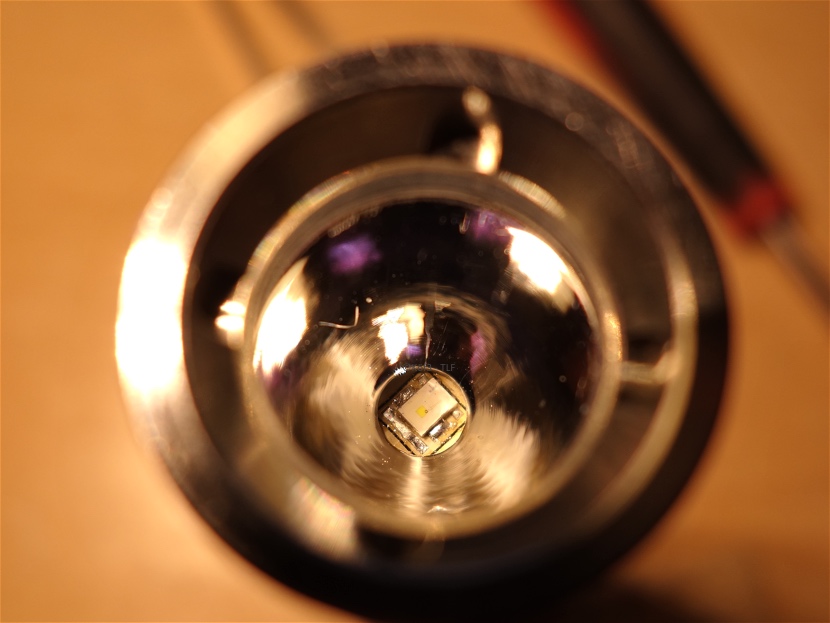LED test / review
EN
Osram SYNIOS P2720 DMLQ31.SG white
KW DMLQ31.SG-7K6LF-EBVF46FCBB46
UPDATE --- 06/23/18 --- raw data added (link)

A few months ago in the german TLF I wrote about an interesting LED series, manufactured by Osram: the SYNIOS P2720. There are some types available, all in same footprint but different die sizes and colors.
In August 2017 I already tested the SYNIOS P2720 DMLN31.SG. This test is outdated, in addition the luminance values stated there are totally wrong (details to my new testing method in this test under 'Luminance').
Important hint for all those BLF members which are active in the german forum too: I’m not longer active in the german forum (TLF) anymore. Despite my currently not so good English I will publish my upcoming tests only in this forum (BLF).
Technical data
Tsp 25°C / If 350 mA
Order code: KW DMLQ31.SG-7K6LF-EBVF46FCBB46
Osram ordering No.: Q65111A7568
Type: single die
Binning: 90 – 149 lm
Rated voltage: typ. 2.95 V (min. 2.75 V, max. 3.50 V)
Max. forward current: 700 mA
Max. surge current (10 µs): 1,000 mA
Viewing angle: typ. 120°
Thermal resistance: typ. 10 K/W (max. 14 K/W)
Junction temp.: 150 °C
I purchased the emitter at Mouser a few months ago.
Official datasheet is available here (Osram website, pdf).
First appearance
Like the other LEDs of the SYNIOS series the dimensions are typ. 2,75 x 2,00 mm (0,108 x 0,0788 in). This enables lower development costs and better customizing of accessoires using this LED. In general, this LED is intended for use in automotive and cycling light.
Because of this unusual size Osram uses a special footprint, which is not fitting on industry-standard PCBs (XP/XM layout) directly.
The housing is made of white epoxy resin, the yellow LED die is covered with a clear layer of silicone. Since the silicon dome known from other high power LEDs is missing, from the side the LED looks very flat, like Black Flat or XP-L HI.

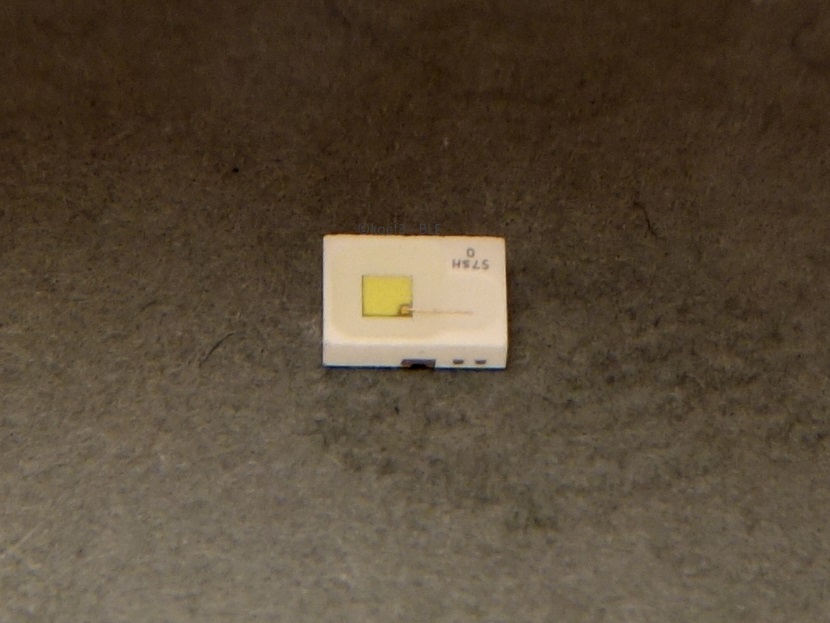

Here is the unique footprint of the SYNIOS. This is the same for all SYNIOS P2720 sold.

The bigger area is the cathode and ensures heat dissipation. The smaller area is the anode and doesn’t fulfills further tasks.
For this test I soldered this LED on a well known Noctigon XP20 DTP copper board, with the cathode on the central thermal pad (like Black Flat). The emitter doesn’t seat itself, and it is strong recommended not using too much solder paste that squeezes out sideways in reflow procedure. Important: if doing so, the cathode is NOT electrically isolated to the flashlight body / heatsink and requires that the board OR the driver electronic is electrically insulated from the heatsink or flashlight body!
Light emitting surface
Like the SYNIOS DMLN31.SG previously tested the light emitting surface is very small. One corner appears like „bitten off“, which reduces the die size considerably and increases the luminance. There is also a white area around the die. This area could affect the luminance and therefore the maximum throw in a negative manner.
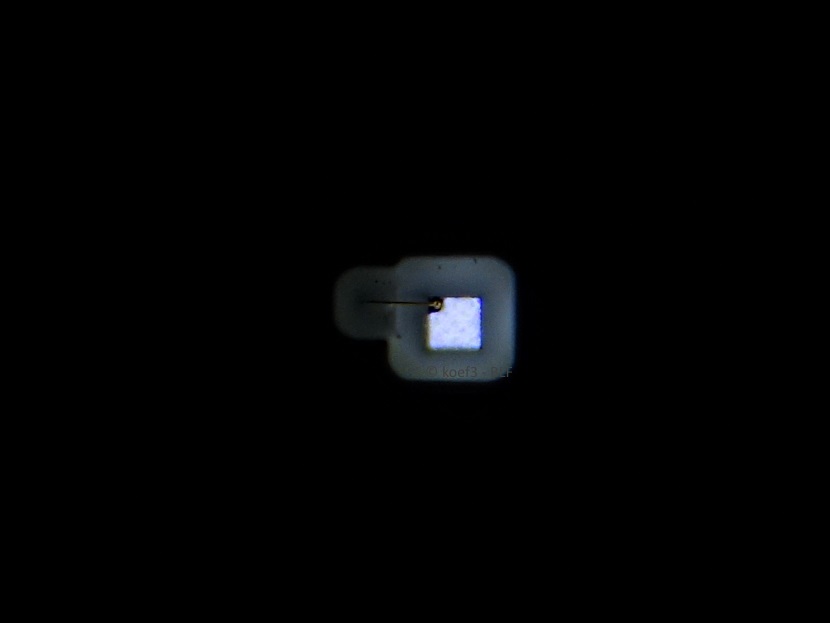
The total light emitting surface area (LES) is 0.503 mm² (0.00078 sq in) in size. According to my measurement the manufacturers specs ('1/2 mm2 chip size class' named in datasheet introduction) are exactly match.
The color consistency is good at all, other colored surfaces next to the white LED chip doesn't exist.
Power and overcurrent capabilities
In the diagram I compare this LED with the XP-E2 and XP-E2 Torch dedomed.


raw data here
Within official parameters
- At 700 mA (max rated current): 215.7 lm @ 3.11 V
- Power at rated maximum: 2.18 W
- Efficiency at 700 mA: 98.9 lm/W
- At 350 mA (binning conditions, 25 °C Tsp): 122.1 lm @ 2.97 V
Overcurrent:
- Maximum at 2,500 mA (461.2 lm @ 3.60 V)
- Power at maximum 9.00 W
- Sweet spot at 1,750 mA (410.7 lm @ 3.41 V)
- Power at sweet spot 5.97 W
- Efficiency at max 51.2 lm/W, in sweet spot 68.8 lm/W
Interesting facts
- Like the SYNIOS P2720 DMLN31.SG the relative luminous flux from 25 to 85 °C Tsp decreases only in 3 percent, unless other LEDs with 9 to 15 percent.
- The Vf is much lower than of the XP-E2.
- The maximum power of this SYNIOS is limited by it's thermal resistance, more than 9 watts aren't possible - a problem which limits the XP-E2 (typ. 9.0 K/W) in its performance too. In comparison the Black Flat with only typ. 3.0 K/W can deliver about 20 watts, at approx. 930 lumens.
- The SYNIOS is a good and efficient replacement for XP-E2, if the very high luminance is needed or desired - the efficiency is almost the same compared to the XP-E2, even in dedomed state (Torch)!
If the white areas around the die are covered with opaque material, the light flux is around 40 to 50 % lower!
Luminance
I established a new method for determining luminance, especially to ensure more realistic values for 'real-life' conditions (flashlight use). The measurements are taken with a new original Convoy C8 reflector, but with same heatsink / setup as previously used in flux measurement.
Reflectivity for reflector 85 %
Transmission UCL glass 97,8 %
Values at 25 °C Tsp, for 85 °C Tsp values are 6 to 14 percent lower, depending on LED
LEDs marked with Warning sign uses old values are still taken with previous method (determining die size) due to problematic light distribution (donut holes etc).
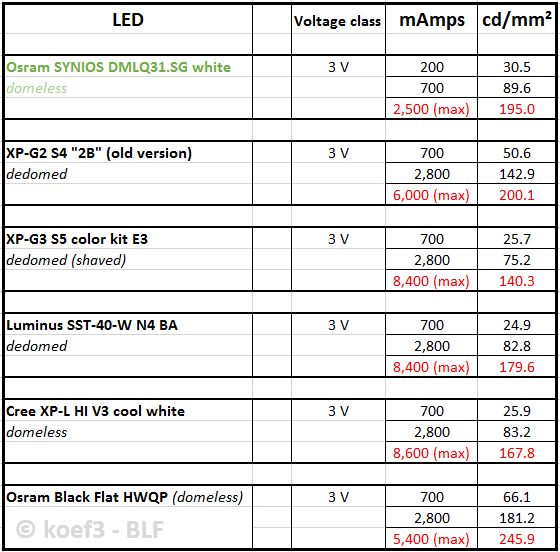
The luminance of the DMLQ31.SG equals to the XP-G2 S4 2B, but at much lower current (and therefore longer runtimes), so this LED might be a very good option for pocket throwers which are limited in the possible battery configuration (10440, 14500). In addition, there is no longer need to dedome this LED.
Light quality and use in optics
As part of this test, I didn’t test the behavior in optics. But because of the strong similarities to the other SYNIOS LED (for more details of this flashlight please click link, german) the light pattern and behavior with optics (TIR/reflector) should be the same. The quality of optics (especially of aspheric lenses!) must as good as possible, otherwise artifacts in the light pattern (rings, dark areas) can occur due to the extremely small chip size. Unfortunately the white surroundings around the die inflates the first measured luminance and lowers the maximum throw possible.
Here some example beamshots of the DMLN31.SG with smaller LED chip, outer reflector diameter 15 mm:

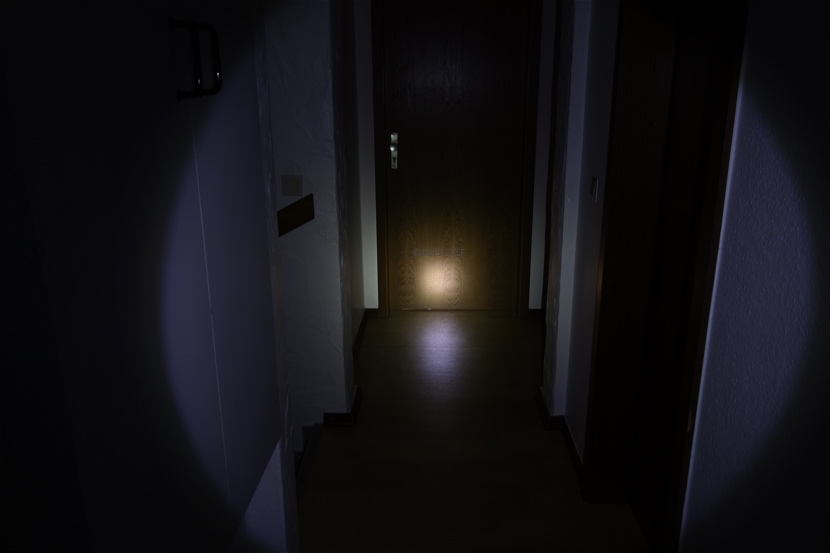
The light color is a clear white without much blue, different to the picture above. I estimate the CRI not higher than 65 – 70, the colors aren’t reproduced good as well which is normal for cool white light sources in this color rendering class.
If the white area around the die is covered with opaque material the tint shifts heavily to blue, at over CCT 10000 K!
Conclusion
For performance in light flux and luminance, this LED could be the little sister of the good old dedomed XP-G2 S4. Almost the same luminance, but at much lower current makes this LED a good option for all those who build a pocket thrower where long runtimes and cooler head are preferred. In addition, there's no longer need the dedome this LED before using.
Unfortunately this LED owns a special footprint, is very small in size which makes the handling more difficult and the maximum power is limited by the thermal resistance which isn't so good as of other LEDs in same power rating.
But if you like cool white colors and big throw even at low power, this LED could be the right choice for you!
Pro
- still high luminance
- luminance at level with dedomed XP-G2 S4 2B but at much lower current
- pure cool white
- pre dedomed
Con
- very small size which makes the handling very difficult
- Special footprint
- Special center rings needed
- Relatively high thermal resistance
Thanks a lot for reading and thanks to be now part of the BLF community! :)
Greetings from germany,
koef3 (in TLF known as Köf3)
Mistakes and suggestions are best sent via pm.
